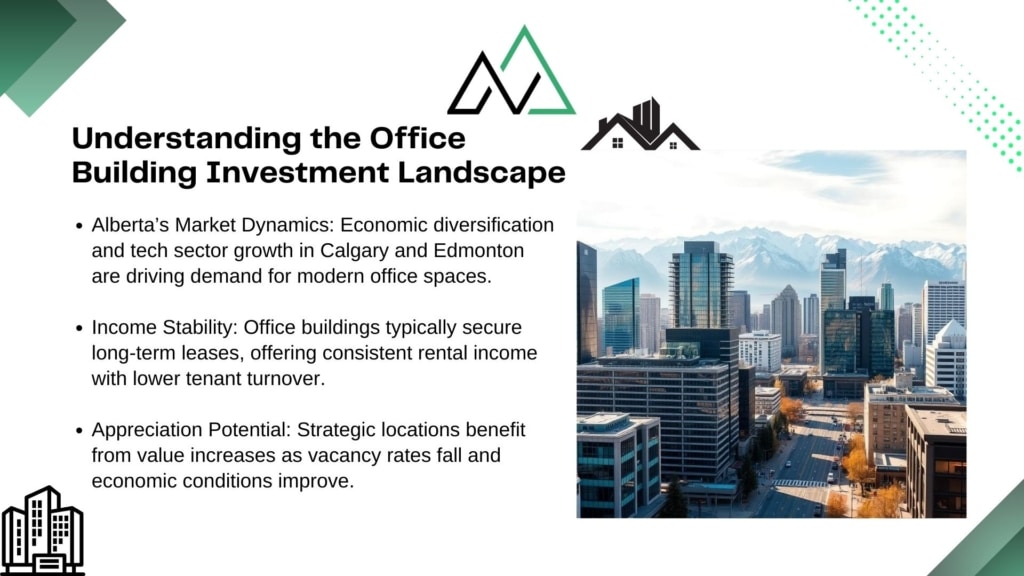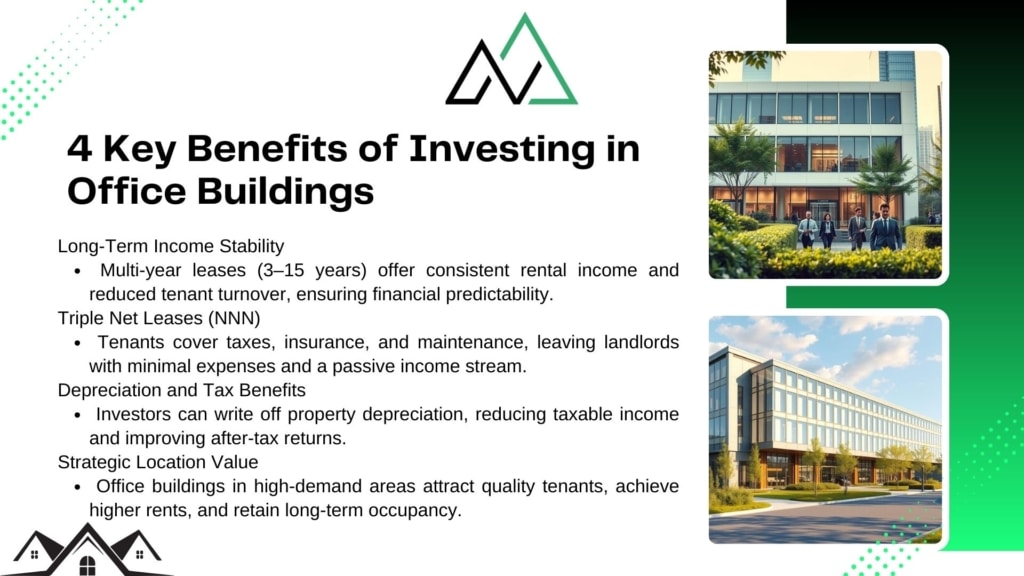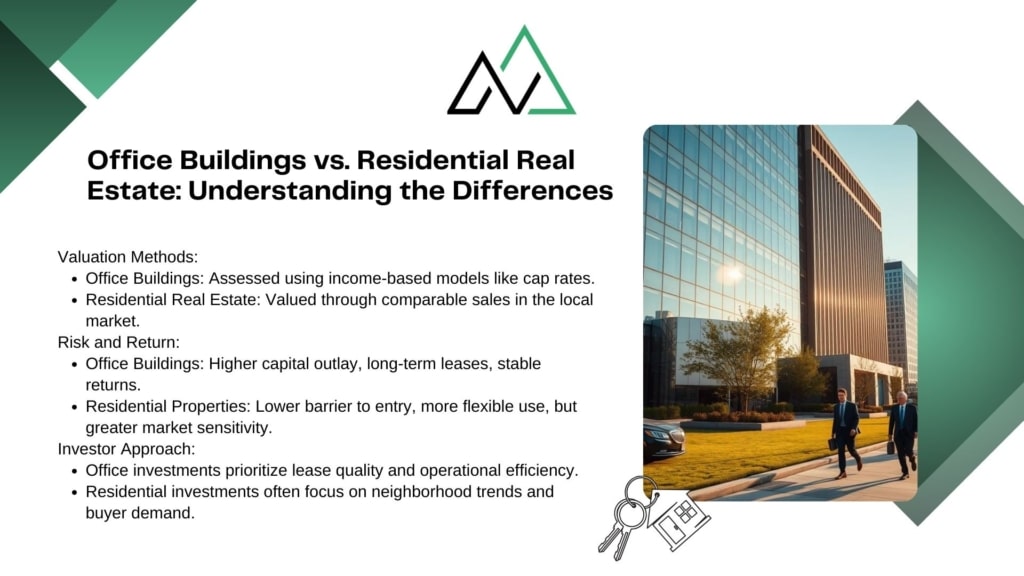Alberta’s commercial real estate market is experiencing a significant shift, with office buildings emerging as a lucrative investment opportunity. As the province’s economy continues to evolve, the demand for quality office spaces is on the rise, presenting a compelling case for investors to diversify their portfolios.
Investing in office buildings can offer a stable source of income and potentially higher returns compared to residential investments. New Homes Alberta, with its expertise in the commercial real estate sector, is well-positioned to guide investors through this complex market. For personalized guidance, you can reach out to them at (403)305-9167.
Key Takeaways
- Alberta’s office building market is poised for growth due to economic evolution.
- Diversifying your portfolio with commercial properties can be beneficial.
- Investing in office buildings can offer stable income and higher returns.
- Expert guidance is crucial for navigating the commercial real estate market.
- New Homes Alberta offers personalized support for investors.
Understanding the Office Building Investment Landscape

Investing in office buildings in Alberta requires a deep understanding of the commercial real estate landscape. The province’s economy, driven by various industries, significantly influences the demand for office spaces.
The Commercial Real Estate Market in Alberta
Alberta’s commercial real estate market is characterized by its resilience and adaptability to economic fluctuations. The current market trends show a steady recovery from previous downturns, with vacancy rates gradually decreasing as the economy diversifies.
The commercial real estate sector in Alberta is influenced by factors such as economic diversification efforts, technological advancements, and changes in workforce demographics. For instance, the growth of the tech industry in cities like Calgary and Edmonton has increased demand for modern office spaces.
Why Office Buildings Can Be Lucrative Investments
Office buildings offer a unique investment opportunity due to their potential for generating stable income through long-term leases. This characteristic makes them attractive to investors seeking predictable cash flow.
- Long-term leases provide a stable source of income.
- Office buildings can appreciate in value over time, especially in areas with growing demand.
- The commercial real estate market in Alberta is supported by a diverse economy, reducing dependence on a single industry.
Investing in office buildings can be lucrative due to the potential for rental income and property appreciation. As the demand for office spaces continues to evolve, investors who understand the market dynamics can capitalize on emerging opportunities.
4 Key Benefits of Investing in Office Buildings

For investors looking to diversify their portfolios, office buildings offer four primary benefits that can enhance their investment strategy. These benefits not only provide a stable source of income but also offer opportunities for long-term growth and financial security.
Long-Term Income Stability
Investing in office buildings typically involves signing multi-year lease agreements, ranging from 3 to 15 years or more. This long-term leasing structure provides investors with predictable cash flow and income stability, a significant advantage over residential real estate, which often has shorter lease terms.
Triple Net Leases (NNN) Advantage
Triple net leases are particularly appealing to investors. In this arrangement, tenants are responsible for property taxes, insurance, and maintenance costs, in addition to the rent. As an investor, your primary responsibility is the mortgage payment, making it a form of passive income.
Depreciation and Tax Benefits
Commercial real estate investments, such as office buildings, offer substantial tax advantages. Investors can benefit from depreciation, which can shelter income and reduce tax liability. This can significantly impact the overall return on investment.
Strategic Location Value
The location of an office building plays a crucial role in its value and rental rates. Buildings situated in growing business districts or commercial centers tend to have higher occupancy rates and command premium rental prices. Strategic location selection is key to maximizing the potential of an office building investment.
| Benefit | Description | Advantage |
|---|---|---|
| Long-Term Income Stability | Multi-year lease agreements | Predictable cash flow |
| Triple Net Leases | Tenants pay taxes, insurance, and maintenance | Passive income for investors |
| Depreciation and Tax Benefits | Depreciation reduces tax liability | Increased return on investment |
| Strategic Location Value | Prime locations command higher rents | Higher occupancy rates and rental income |
Office Buildings vs. Residential Real Estate: Understanding the Differences

Distinguishing between office buildings and residential real estate is essential for making informed investment decisions. The two types of properties differ significantly in their valuation methods, risk profiles, and investment characteristics.
Income-Based Valuation vs. Comparable Sales
The value of office buildings is primarily determined by their income potential, using methods such as the capitalization rate. This approach considers factors like tenant quality, lease terms, and operational expenses. In contrast, residential real estate is typically valued based on comparable sales data, where recent sales of similar properties in the same area are used as benchmarks. This fundamental difference in valuation methodology affects how investors approach these two types of properties.
Different Risk and Return Profiles
Office buildings and residential real estate also exhibit different risk and return profiles. Office buildings usually require larger capital investments but can offer more stable long-term returns through rental income. Residential properties, while potentially offering quicker returns through flipping or rental income, may be more susceptible to market fluctuations. Understanding these differences is crucial for investors to manage their portfolios effectively and make strategic decisions about their investments in commercial real estate and residential markets.
How to Invest in Office Buildings: A Step-by-Step Guide
The journey to investing in office buildings begins with a clear understanding of one’s investment goals and financial capacity. Investors must assess their risk tolerance, financial resources, and long-term objectives to determine if office building investment aligns with their overall strategy.
Assessing Your Investment Goals and Capacity
Determining investment budget is crucial, including considerations for down payment, closing costs, renovation expenses, and operational reserves. Investors should evaluate their financial capacity to undertake such a significant investment.
Assembling Your Expert Advisory Team
A specialized advisory team is essential for successful office building investment. This team should include a commercial real estate agent, property attorney, accountant, mortgage broker, and property inspector with specific office building expertise.
Securing Appropriate Financing
Various financing options are available for office building acquisition, including traditional commercial mortgages, SBA loans, seller financing, and private equity partnerships. Understanding the impact of interest rates and loan terms on commercial property investments is vital.
Finding the Right Property
A systematic approach to property selection involves location analysis, building condition assessment, tenant quality evaluation, and income potential verification. Conducting thorough due diligence, including environmental assessments and title searches, is also crucial.
By following these steps and creating a comprehensive business plan for each potential office building investment, investors can make informed decisions and achieve their investment goals.
Types of Office Buildings and Which to Choose
The office building landscape is diverse, with different types and classes that can significantly impact investment returns. Understanding these variations is crucial for making informed decisions in the commercial real estate market.
Class A, B, and C Office Buildings
Office buildings are categorized into Class A, B, and C based on their age, quality, and rental income potential. Class A buildings are modern, prestigious, and command high rents, typically appealing to large corporations. Class B buildings are older but well-maintained, offering a balance between quality and cost, making them suitable for a wide range of tenants. Class C buildings are the oldest and often require renovation, presenting opportunities for value-add investments.
High-Rise, Mid-Rise, and Low-Rise Properties
Office buildings are also classified by their height: high-rise (skyscrapers), mid-rise (3-24 floors), and low-rise (1-3 floors). High-rise buildings offer prestige and high-density occupancy, while mid-rise properties balance cost and accessibility. Low-rise buildings provide flexibility and are often preferred by smaller businesses or those seeking a more personalized environment.
Specialty Office Buildings: Medical, Government, and Business Parks
Specialty office buildings cater to specific industries, such as medical offices, government facilities, and business parks. These properties offer unique advantages, like stable tenant bases in medical offices or synergistic environments in business parks. Understanding the niche requirements and potential of these specialty buildings can uncover lucrative investment opportunities.
By understanding the different types of office buildings and their characteristics, investors can make informed decisions that align with their investment goals and risk tolerance in the Alberta commercial real estate market.
Understanding Office Building Leases and Terms
Office building leases come in various forms, each with its unique benefits and drawbacks. Understanding these lease structures is crucial for investors to make informed decisions in the commercial real estate market.
Gross, Modified, and Triple Net Leases Explained
In office buildings, there are three primary types of leases: Gross Lease, Triple Net Lease (NNN), and Modified Gross Lease. A Gross Lease benefits the tenant the most, as they only pay rent, while the landlord handles other expenses. On the other hand, a Triple Net Lease benefits the landlord, as the tenant pays for most expenses in addition to rent. A Modified Gross Lease falls somewhere in between, with the distribution of expenses negotiable between the landlord and tenant.
Each lease type has its advantages and disadvantages. For instance, Triple Net Leases are popular among investors because they provide a relatively passive income stream. Understanding these lease structures is essential for investors to manage their properties effectively and maintain positive relationships with their tenants.
10 Essential Office Building Investment Terms
To navigate the complex world of office building investments, one must be familiar with key terms. These include Rentable Square Footage, Gross Leasable Area, Load Factor, Capitalization Rate, and Tenant Improvement Allowances. Understanding these terms helps investors analyze potential investments, negotiate leases, and manage their properties more effectively.
Other essential terms include Common Area Maintenance (CAM) charges, Lease Escalation Clauses, and Tenant Renewal Options. Familiarity with these terms enables investors to make more informed decisions and avoid potential pitfalls in the commercial real estate market.
Potential Pitfalls and How to Avoid Them
Investing in office buildings can be lucrative, but it’s crucial to be aware of the potential pitfalls that come with this type of investment. Understanding these risks is key to making informed decisions and maximizing returns.
Economic Cycle Risks
Office building investments are significantly affected by economic cycles. During economic downturns, occupancy rates and rental income can plummet. To mitigate this risk, investors should monitor the real estate cycle closely and consider purchasing properties during downturns.
Tenant Concentration and Lease Expiration
Having a single large tenant can pose a significant risk if they decide to leave. To protect against this, investors should diversify their tenant base and establish a reserve fund to cover potential vacancies. Additionally, staggering lease expirations can help avoid multiple vacancies at once.
Maintenance and Obsolescence Challenges
Office buildings require regular maintenance to remain competitive. This includes updating major systems like HVAC and security, as well as adapting to changing workplace needs. Failure to do so can lead to functional obsolescence, making the property less attractive to potential tenants.
Strategies for Risk Mitigation
To minimize risks, investors should implement comprehensive risk mitigation strategies. This includes maintaining adequate cash reserves, conducting thorough tenant screening, and engaging in proactive property management. By being prepared, investors can navigate potential challenges more effectively.
Conclusion: Taking the Next Step with New Homes Alberta
Investing in office buildings represents a significant step for many real estate investors, requiring careful consideration and strategic planning. As we’ve discussed, office building investments in Alberta’s commercial real estate market offer a unique blend of income stability and long-term appreciation potential. To succeed, it’s crucial to assess your investment goals, risk tolerance, and financial capacity. New Homes Alberta’s expertise can guide you through the complexities of commercial real estate, from property selection to acquisition and management. With the right approach and professional guidance, office building investments can become a valuable part of a diversified real estate portfolio. Contact New Homes Alberta at (403)305-9167 to discuss your office building investment goals and opportunities.
FAQ
What are the key factors to consider when evaluating the potential of an office building investment?
When assessing an office building investment, consider factors such as location, property condition, tenant quality, lease terms, and local market trends to ensure a stable cash flow and potential for long-term appreciation.
How do triple net leases benefit office building investors?
Triple net leases shift expenses such as property taxes, insurance, and maintenance to the tenant, reducing the investor’s operational burdens and providing a more predictable income stream.
What is the difference between Class A, B, and C office buildings?
Class A office buildings are high-quality, modern structures in prime locations, commanding the highest rents. Class B buildings are well-maintained but may not be as modern or in as prime locations, while Class C buildings are older and may require renovation.
What are the risks associated with office building investments?
Risks include economic downturns, tenant vacancies, lease expirations, and maintenance or obsolescence challenges. Mitigating these risks requires careful planning, diversification, and ongoing property management.
How do office building investments compare to residential real estate in terms of risk and return?
Office building investments typically offer more stable income and potentially lower volatility compared to residential real estate, but may require larger upfront investments and involve different market dynamics.
What role does location play in the success of an office building investment?
Location is critical, as it affects the property’s attractiveness to tenants, its potential for rental income, and its long-term appreciation. Desirable locations with good accessibility and amenities tend to perform better.
What are the benefits of working with a professional advisory team when investing in office buildings?
A professional advisory team can provide expertise in areas such as property valuation, market analysis, financing options, and legal matters, helping investors make informed decisions and navigate complex transactions.
How can investors secure appropriate financing for an office building investment?
Investors can explore various financing options, including commercial mortgages, partnerships, and private equity. Understanding the terms, interest rates, and repayment requirements of each option is crucial for making an informed decision.





